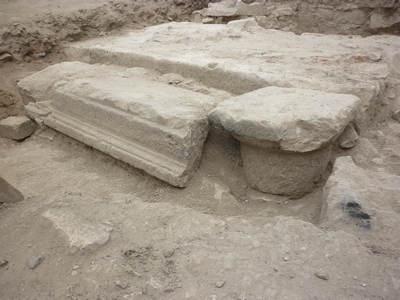Glenn Maffia on the ongoing excavations at the Apollo Temple
IT HAS been a hot and sweaty week in which the labourers have had to dig. Clearing and breaking the initial ground is always the most arduous and tedious chore, if for nothing more than the rewards are never instantly forthcoming.
To be sure a large amount of antique stonework is revealed, though this is merely a confusion of rubble stolen by much later generations which is strewn in a haphazard manner just under the surface of the ground. Nonetheless, it all must be sifted and recorded; a time consuming task.
It may seem strange to people that the past is the key to the future, though it is an oft quoted remark of Karl Marx, but already the archaeologists have posed questions in my mind.
 The question doesn’t concern evidence rather than the lack of it. For history appears to stop from the fifth or sixth century until the nineteenth altogether. In what may be called ‘The Curious Case of the Missing Centuries’.
The question doesn’t concern evidence rather than the lack of it. For history appears to stop from the fifth or sixth century until the nineteenth altogether. In what may be called ‘The Curious Case of the Missing Centuries’.
Though history can answer the anomaly sufficiently I feel.
Circumstances do not change overnight, they evolve as all else does, slowly and over a protracted length of time.
Thus “it came to pass” that first the Roman Republic disintegrated, then the Roman Empire buckled under the constant stress of human migrations and as its limits of power and influence stretched its resources, especially human, too thinly to adequately control its self defined boundaries.
The natural force of change caused cracks in the fabric of Roman social and, importantly, religious life. Those that were once subjugated now began to make themselves heard and their influence showed itself in the political arena.
A Roman Emperor, Constantine, finally ceded to inevitable pressure and declared that the new religion of Rome and its domains be that of Christianity.
The rich pagan past was doomed, even though this, once again, was not an immediate change; one cannot tell people what to believe, that is for the individual to struggle with.
Naturally, the now dominant Christians, oppressed and brutalized for three centuries, were not cast in the image they purport to be now; believers in love and peace and goodwill to all men (and presumably women). We would view them as fundamentalist bigots with vengeance firmly imprinted on their minds.
 Therefore when the barbarity of a new dominant ideology in religious terms appeared it was a fait accompli that it be would retribution more earthly than divine.
Therefore when the barbarity of a new dominant ideology in religious terms appeared it was a fait accompli that it be would retribution more earthly than divine.
Either Constantine (ruled 306-337) or Theodosius (379-395), or both for religions do not fade away so easily, perpetuated genocide and the destruction of pagan shrines in the name of their belief. Sound familiar today?
The priests and believers were all slaughtered. The pagan temples and shrines were torn down; but not Apollo’s, for presumably it was too massive an undertaking to do so. Therefore it was ignored, with a rather feeble Christian church erected inside the Adyton (central court).
 A once prosperous centre gradually declined into almost extinction, though pottery evidence supports a long and uninterrupted human occupation.
A once prosperous centre gradually declined into almost extinction, though pottery evidence supports a long and uninterrupted human occupation.
Possibly the land was then farmed by small holders, scratching out a living from the harsh land, and they may have used half demolished dwellings as a shelter in much the same way that the residents around the temple today have done so.
Indeed, we can tell much about the past from the way people live today. If we walk around the village that encircles the Temple it is clearly apparent that much of the stone of ancient Didyma has been used for the walls of the Greek settlement which emerged. Though any permanent intermediate buildings appear to vanish from the timeline.